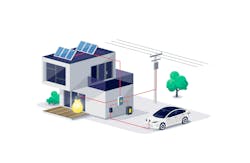Virtual Power Plants Could Save Californians $550M per Year by 2035: Brattle Group Report
Virtual is quickly becoming reality.
Virtual power plant (VPP) capacity in California could potentially exceed more than 7,500 MW by 2035, according to new research released by The Brattle Group and GridLab. That’s more capacity than the largest physical power plant in the state and higher than the peak demand of the city of Los Angeles.
The Brattle Group also found that by 2035 VPPs will have the potential to save consumers more than $550 million each year, avoid more than $750 million annually in traditional power system costs, ease current energy challenges, improve grid reliability and advance the state’s efforts to create a sustainable and reliable energy system.
Harnessing the power of distributed energy resources
VPPs use an intelligent control system and bidirectional technology to aggregate energy from networked resources located at multiple sites, such as solar plus storage systems, electric vehicles (EVs) and other distributed energy resources (DERs). The technology creates a reliable power network by bundling together what could be hundreds of discrete power sources into one that can be dispatched during times of peak demand, just as a centralized power plant would.
In recent years, California has been plagued with blackouts because of power supply shortages largely driven by extreme weather events and an extended drought that has reduced the flexibility of hydro-based power generation. According to the report, resource adequacy costs, or the costs to ensure electric supply will be sufficient to meet demand, have doubled since 2017.
At the same time, businesses and residents alike have been rapidly adopting clean smart home technologies, EVs, solar arrays and batteries for energy storage.
California’s Virtual Power Potential: How Five Consumer Technologies Could Improve the State’s Energy Affordability examined the impact of harnessing smart thermostat-based air-conditioning controls, behind-the-meter batteries, residential EV charging, grid-interactive water heating and automated demand response systems for large commercial buildings and industrial facilities into VPPs.
The study found that forming VPPs with these diverse, commercially available, dispatchable technologies is indeed a viable solution to California’s growing energy problems.
“In the face of rapidly rising utility bills across the state, this report shows the tremendous potential of VPPs to provide affordable, clean generating capacity as well as critical support for grid reliability,” said Ric O’Connell, executive director of GridLab. “VPPs can play an important role in helping California achieve its goal of 100% clean electricity by 2045.”
VPPs can be built quickly
The study pointed out that VPPs can reduce the risks associated with interconnection delays and other regulatory hurdles. “They can be ‘built’ essentially as quickly as customers adopt technologies and enroll,” the study’s authors said, adding that “VPPs can scale flexibly as demand grows, mitigating risks due to unprecedented uncertainty in electricity demand forecasts.”
VPP technologies have been deployed across the U.S., further proving their potential to improve grid reliability and provide economic benefits to both consumers and utilities.
VPPs will be in Focus at Microgrid 2024
Happening April 22-24 in Baltimore
Sessions Featuring Ameren, PXISE, CPower, Uplight
Register now to Witness the Revolution in Energy
Participants are compensated in the form of incentive payments, which could be between $500 and $1,000 per year, according to the study. Utilities, in the meantime, can use VPPs to avoid the costs associated with building new expensive infrastructure projects.
The study pointed to high levels of enrollment in similar programs in Minnesota, Vermont and other states.
Puget Sound Energy, Washington state’s largest utility, recently announced it was expanding its VPP partnership with software company AutoGrid in an effort to reduce costs and improve the reliability of its energy supply. Likewise, the Public Utility Commission of Texas is running two VPP pilot programs that coordinate the operation of consumer-owned connected devices to create another dispatchable power source for the Electric Reliability Council of Texas during times of high demand.
In California, San Diego Gas & Electric is already running a VPP pilot project to help the grid meet electricity demand when summer temperatures rise.
“Barriers to achieving VPP potential still remain, but our study shows that initiatives to overcome those barriers will be well worth the effort,” noted Ryan Hledik, the study’s lead author and principal at The Brattle Group. “At achievable levels of participation and with technologies that are commercially available today, the potential impact of VPPs in California’s energy transition over the coming decade is simply too big to ignore.”








